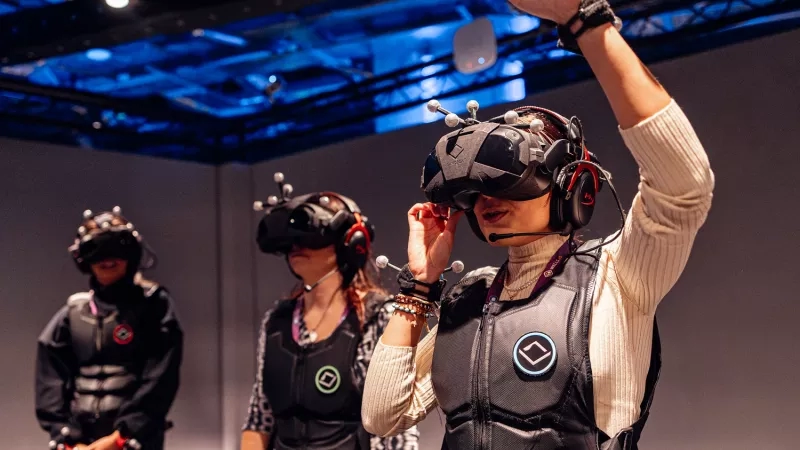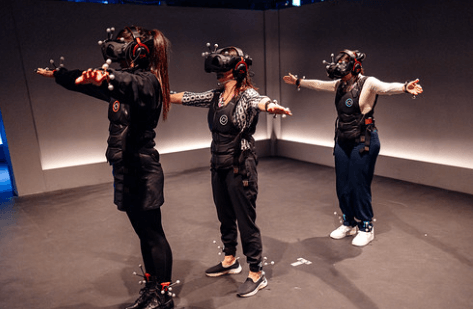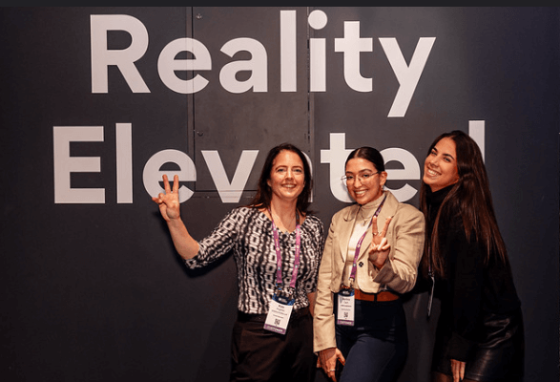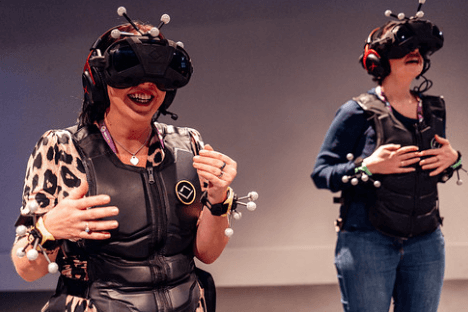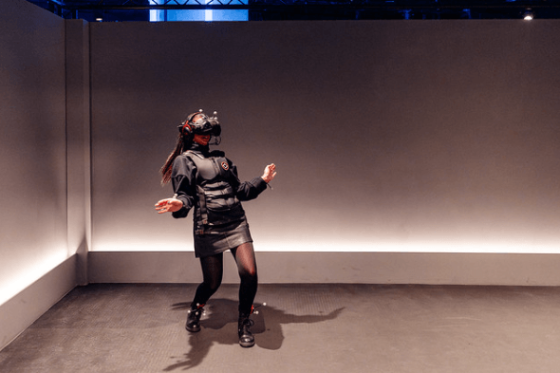Virtual reality (VR) isn’t new. But its role in events has shifted—from something experimental to something planners are being asked to deliver.
Whether it’s a product launch, internal training, or full-scale conference, more clients are exploring VR as a way to create a presence without the cost of travel. As expectations for virtual events and experiences continue to rise, planners must understand what VR can realistically achieve and when it’s worth the effort.
This guide breaks down what VR means in the context of events, how it works, and what it takes to get it right.
What is virtual reality?
Virtual reality is a technology that creates a simulated environment people can experience through a headset. Instead of looking at a screen, users are placed inside a digital space that feels three-dimensional. They can look around, move through it, and interact with what’s in front of them.
Virtual reality is part of what’s known as extended reality, which also includes augmented and mixed reality. Together, these technologies are growing fast. The extended reality market is expected to reach $472.39 billion by 2029, growing at nearly 35% year-over-year.
For events, this opens up new ways to engage attendees. Virtual and augmented reality for events can help you build a virtual showroom, a training space, or even recreate a venue for people who can’t attend in person.
What is a virtual reality event?
A virtual reality event is one where attendees join through a VR platform rather than walking into a physical venue. They wear headsets or, in some cases, use a browser and enter a digital environment where the event takes place.
That environment might be designed to look like a real conference hall, a product demo space, or something entirely custom. Attendees can move through it, talk to people, and interact with the content. Some events use full avatars. Others keep it simple with clickable spaces and voice chat.
These formats work across use cases. They’re used in virtual reality conferences, internal team training, and even onboarding sessions. Some companies use them to host virtual reality trade shows or run live VR events when a physical setup isn’t possible.
For corporate teams, a virtual reality meeting can provide more structure and presence than a typical video call, especially when the goal is collaboration rather than just updates.
How to do virtual reality in events
Virtual reality events aren’t hard to pull off, but they aren’t something you can wing either. If you’re planning one, here’s how to approach it step by step.
Start with the format
Before anything else, define the type of event you're running. Is this a virtual reality conference with a large audience and multiple sessions? A closed-door strategy meeting? A product showcase that needs interaction?
The format will determine the kind of environment you need, how much customization is required, and whether attendees will need VR headsets or can access it through a browser.
Choose the right platform
Once you’ve nailed the format, choose a platform that fits the experience. Some tools are built for headset use, while others work on desktop or mobile without extra gear. You don’t always need a complete 3D setup, especially if your audience is attending from home or joining on short notice.
Check for features like branded environments, real-time voice chat, navigation tools, and analytics. And make sure the learning curve isn’t too steep. If it takes 30 minutes to figure out how to move around, your audience will check out before the event even begins.
Think about your content flow
VR changes how people experience time and space. You can’t copy-paste a physical/hybrid event or live-stream format and expect it to land the same way.
Keep sessions tighter, include breaks in between, and think less about back-to-back keynotes and more about movement, exploration, and interaction. You can still schedule speakers and panels, but plan them to fit the pacing of a virtual space, not a ballroom.
Also, consider onboarding. People need time to adjust to the environment, understand how to navigate, and test their audio before diving into content. If you skip that step, you’ll spend half the event on tech support.
Prep your audience
Most people haven’t joined a VR event before. If you don’t walk them through what to expect, you’ll lose half your room to tech issues before the event even starts. Therefore, send prep materials early. Ensure they know how to log in and troubleshoot the basics if something goes wrong. The more confident they feel walking in, the more present they’ll be during the event.
Test everything
Try the full experience ahead of time, just like an attendee would. Log in with a slow connection. Try a different device with bad Wi-Fi in the middle of the day when everything else is competing for bandwidth. Walk the whole space. If something feels clunky or confusing, it’s not ready.
5 ways of using VR in events
While VR can be used for virtual tours of hotels and real estate properties, some practical applications in the MICE industry are:
1. Product demos
If your product is something people need to see up close, VR makes that possible without the need for a physical booth, shipping logistics, or a flight. You can walk prospects through features, scale, and functionality inside a fully interactive environment. VR is great for product launches, especially in B2B tech, manufacturing, and automotive. It also works well for VR corporate events where the goal is to show, not tell.
2. Trade shows
VR lets you scale a trade show without worrying about venue size, floor plans, or print deadlines. You can give each exhibitor a custom booth that feels like their space, something that’s hard to pull off in a physical event. Some companies go all in with fully virtual reality trade shows. Others add VR as a layer inside their physical booth, especially when space is tight, but they want to show more.
3. Internal meetings
Virtual reality meetings give teams a space to collaborate without succumbing to Zoom fatigue. VR helps create environments that are ideal for strategy sessions, team-building, or onboarding moments. It works exceptionally well where people need to focus and interact rather than multitask through another video call.
4. Conferences
You can create a comprehensive virtual reality conference featuring keynotes, breakout sessions, sponsor zones, and attendee lounges. The difference is in the level of interaction. Instead of chat boxes and comment threads, you get face-to-face conversation inside the space. Some conferences also use VR to layer in guided networking, live polling, and Q&A, with attendees moving naturally between sessions like they would in real life.
5. Training and workshops
VR makes sense for hands-on workshops, onboarding, or upskilling programs where context matters. Instead of just showing slides, you place people inside scenarios, whether it’s a simulated operating room, an engineering line, or a customer service floor. This format is already being used in healthcare, aviation, and manufacturing industries, where process and safety training benefits from immersion.
Benefits and drawbacks of virtual reality events
Where VR delivers
For the right event, VR can solve a lot of the usual problems. You don’t need to fly people in. You don’t need to worry about venue capacity or room layouts. You can create something once and scale it across time zones, teams, or global offices without having to start from scratch each time.
The format also opens up creative freedom. You can design environments that match your brand, guide people through a sequence, or build interactive elements that aren’t possible in a standard webinar. Engagement feels less forced when the space is doing part of the work.
There’s also value in what happens behind the scenes. Most platforms track movement, dwell time, interactions, and behavior, giving you clean data that you can use to improve the next round. And for clients focused on sustainability, removing flights and venue costs from the equation is a clear win.
Where VR still struggles
VR isn’t plug-and-play. If someone needs a headset to get the whole experience, you’ve already lost part of your audience. Most planners end up choosing platforms that work on desktops for accessibility, but that limits some of what VR can do.
There’s also the question of comfort. Not everyone enjoys spending time on a headset. Some get motion sick while others find it clunky. And even if the tech works on your end, the moment it breaks for someone else—lag, sound issues, login problems—you lose their attention, and you probably don’t get it back.
Another challenge is the social side. VR environments feel immersive, but they don’t always feel personal. You can recreate the space, but not always the spontaneity of in-person interaction. For events where networking is the main value, that’s something to think about.
Finally, there’s the build itself. Good VR experiences take time, budget, and technical partners who know what they’re doing. If you’re short on any of those, you’ll feel the limitations fast.
Virtual Reality Event Planning: 8 Best Practices
1. Know who’s showing up
Before you pick a platform or plan the space, you need to know your audience. Not just the headcount: How comfortable are they with tech? Have they used VR before? Are they dialing in from a corporate laptop or a personal device? This isn’t about dumbing things down. It’s about setting them up to participate instead of spending half the event figuring out which button to press.
2. Pick a platform that doesn’t get in the way
You don’t need something cutting-edge. You need something stable. The event management software you choose should match the format, audience, and level of support you have on the day. If it takes a 20-minute tutorial to log in, you’ll lose people before the first session starts. Go for usability, not flash. If the experience is smooth, no one will care whether the avatars blink or not.
3. Build content that holds attention
VR makes bad content feel worse. In a virtual space, people have even more ways to disengage--they can log off, mute, wander off, and pretend to freeze. So, the format has to do some of the heavy lifting. That means tighter sessions, more movement, more interaction. If you’re planning a panel, keep it short. If it’s a demo, make it hands-on. You’re not fighting for attention; you’re building something that earns it.
4. Have real support on standby
There will be questions. There will be login issues. Someone’s mic won’t work. Someone won’t know how to move. This doesn’t require an entire IT team, but it does mean having at least one person available who knows the platform inside out. Because if you want people to stay at the event, you need to help them stay at the event.
5. Plan for different access levels
Not everyone will have a headset. And even if they do, not everyone will want to use it for two hours straight. Ensure there’s a way to join by desktop or plan the event format so headset users get the whole experience, but no one else is left out. Accessibility isn’t a bonus here. It’s the baseline.
6. Dry run
This isn’t a five-minute tech check. Walk through the entire event from start to finish. Join as an attendee. Try different devices. See where things slow down, where people might get confused, and where navigation gets clunky. Fix it early. If something goes wrong on the day, it should never be the first time you’ve seen it.
7. Collect feedback
Ask attendees what worked and what didn’t. Don’t settle for star ratings or vague praise. What confused them? Where did they feel engaged? Where did they drop off? That kind of feedback sharpens every event that comes after.
8. Use tools to cut down the chaos
If you’re running multiple sessions, teams, or touchpoints, don’t try to manage it all in a spreadsheet. Event management tools that work with VR platforms help you organize with ease, particularly when you’re dealing with attendee communications, reminders, or post-event reporting. It’s one less thing to hold in your head.
Plan VR events with confidence
Virtual reality isn’t a novelty add-on anymore. Clients are asking about it, and planners need to know how to deliver it. That doesn’t mean using it for every event. It means knowing where it fits, what it takes to do it well, and what to avoid.
The learning curve is real, but so is the demand. The VR market is expected to grow from under $12 billion in 2022 to over $22 billion by 2025. That growth is being driven by teams looking for better ways to engage, not just cheaper ways to meet.
If you're planning events in 2025, this is part of the toolkit now.

